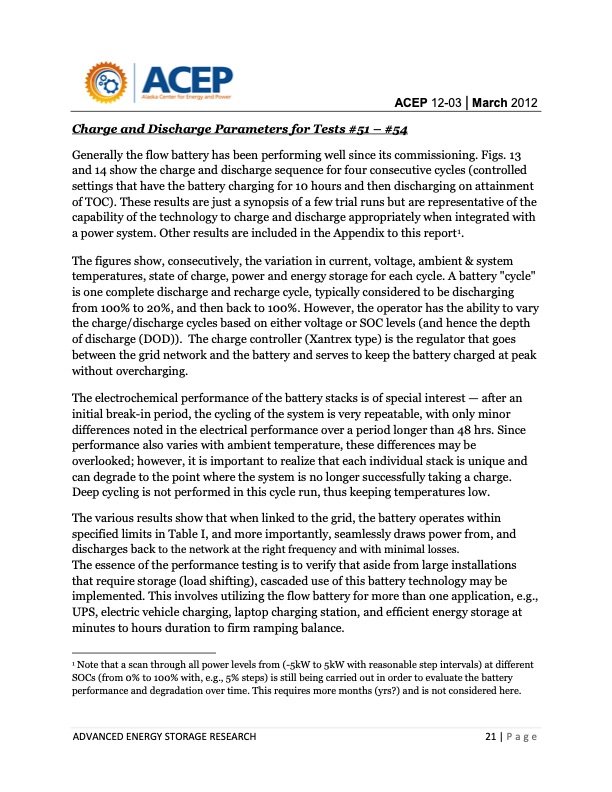
PDF Publication Title:
Text from PDF Page: 033
ACEP 12-03 | March 2012 Charge and Discharge Parameters for Tests #51 – #54 Generally the flow battery has been performing well since its commissioning. Figs. 13 and 14 show the charge and discharge sequence for four consecutive cycles (controlled settings that have the battery charging for 10 hours and then discharging on attainment of TOC). These results are just a synopsis of a few trial runs but are representative of the capability of the technology to charge and discharge appropriately when integrated with a power system. Other results are included in the Appendix to this report1. The figures show, consecutively, the variation in current, voltage, ambient & system temperatures, state of charge, power and energy storage for each cycle. A battery "cycle" is one complete discharge and recharge cycle, typically considered to be discharging from 100% to 20%, and then back to 100%. However, the operator has the ability to vary the charge/discharge cycles based on either voltage or SOC levels (and hence the depth of discharge (DOD)). The charge controller (Xantrex type) is the regulator that goes between the grid network and the battery and serves to keep the battery charged at peak without overcharging. The electrochemical performance of the battery stacks is of special interest — after an initial break-in period, the cycling of the system is very repeatable, with only minor differences noted in the electrical performance over a period longer than 48 hrs. Since performance also varies with ambient temperature, these differences may be overlooked; however, it is important to realize that each individual stack is unique and can degrade to the point where the system is no longer successfully taking a charge. Deep cycling is not performed in this cycle run, thus keeping temperatures low. The various results show that when linked to the grid, the battery operates within specified limits in Table I, and more importantly, seamlessly draws power from, and discharges back to the network at the right frequency and with minimal losses. The essence of the performance testing is to verify that aside from large installations that require storage (load shifting), cascaded use of this battery technology may be implemented. This involves utilizing the flow battery for more than one application, e.g., UPS, electric vehicle charging, laptop charging station, and efficient energy storage at minutes to hours duration to firm ramping balance. 1 Note that a scan through all power levels from (-5kW to 5kW with reasonable step intervals) at different SOCs (from 0% to 100% with, e.g., 5% steps) is still being carried out in order to evaluate the battery performance and degradation over time. This requires more months (yrs?) and is not considered here. ADVANCED ENERGY STORAGE RESEARCH 21 | P a g ePDF Image | Advanced Battery Storage Systems Testing at ACEP VRB ESS

PDF Search Title:
Advanced Battery Storage Systems Testing at ACEP VRB ESSOriginal File Name Searched:
ACEP-VRB-Testing-Report.pdfDIY PDF Search: Google It | Yahoo | Bing
Salgenx Redox Flow Battery Technology: Salt water flow battery technology with low cost and great energy density that can be used for power storage and thermal storage. Let us de-risk your production using our license. Our aqueous flow battery is less cost than Tesla Megapack and available faster. Redox flow battery. No membrane needed like with Vanadium, or Bromine. Salgenx flow battery
| CONTACT TEL: 608-238-6001 Email: greg@salgenx.com | RSS | AMP |